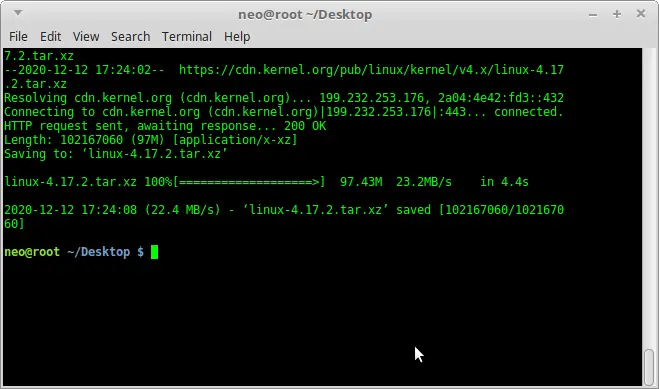
How To Use Wget Command in Linux

GNU Wget is a command-line utility for downloading files from the web. With Wget, you can download files using HTTP, HTTPS, and FTP protocols. Wget provides a number of options allowing you to download multiple files, resume downloads, limit the bandwidth, recursive downloads, download in the background, mirror a website, and much more.
This article shows how to use the wget command through practical examples and detailed explanations of the most common options.
Installing Wget
The wget package is pre-installed on most Linux distributions today.
To check whether the Wget package is installed on your system, open up your console, type wget, and press enter. If you have wget installed, the system will print wget: missing URL. Otherwise, it will print wget command not found.
If wget is not installed, you can easily install it using the package manager of your distro.
Installing Wget on Ubuntu and Debian
$ sudo apt install wgetInstalling Wget on CentOS and Fedora
$ sudo yum install wgetWget Command Syntax
Before going into how to use the wget command, let’s start by reviewing the basic syntax.
The wget utility expressions take the following form:
$ wget [options] [url]options– The Wget optionsurl– URL of the file or directory you want to download or synchronize.
How to Download a File with wget
In its simplest form, when used without any option, wget will download the resource specified in the [url] to the current directory.
In the following example, we are downloading the Linux kernel tar archive:
$ wget https://cdn.kernel.org/pub/linux/kernel/v4.x/linux-4.17.2.tar.xz
As you can see from the image above, wget starts by resolving the domain’s IP address, then connects to the remote server and starts the transfer.
During the download, wget shows the progress bar alongside the file name, file size, download speed, and the estimated time to complete the download. Once the download is complete, you can find the downloaded file in your current working directory .
To turn off the output, use the -q option.
If the file already exists, wget will add .N (number) at the end of the file name.
Saving the Downloaded File Under Different Name
To save the downloaded file under a different name, pass the -O option followed by the chosen name:
$ wget -O latest-hugo.zip https://github.com/gohugoio/hugo/archive/master.zipThe command above will save the latest hugo zip file from GitHub as latest-hugo.zip instead of its original name.
Downloading a File to a Specific Directory
By default, wget will save the downloaded file in the current working directory. To save the file to a specific location, use the -P option:
$ wget -P /mnt/iso http://mirrors.mit.edu/centos/7/isos/x86_64/CentOS-7-x86_64-Minimal-1804.isoThe command above tells wget to save the CentOS 7 iso file to the /mnt/iso directory.
Limiting the Download Speed
To limit the download speed, use the --limit-rate option. By default, the speed is measured in bytes/second. Append k for kilobytes, m for megabytes, and g for gigabytes.
The following command will download the Go binary and limit the download speed to 1MB:
$ wget --limit-rate=1m https://dl.google.com/go/go1.10.3.linux-amd64.tar.gzThis option is useful when you don’t want wget to consume all the available bandwidth.
Resuming a Download
You can resume a download using the -c option. This is useful if your connection drops during a download of a large file, and instead of starting the download from scratch, you can continue the previous one.
$ wget -c http://releases.ubuntu.com/18.04/ubuntu-18.04-live-server-amd64.isoIf the remote server does not support resuming downloads, wget will start the download from the beginning and overwrite the existing file.
Downloading in Background
To download in the background, use the -b option. In the following example, we are downloading the OpenSuse iso file in the background:
$ wget -b https://download.opensuse.org/tumbleweed/iso/openSUSE-Tumbleweed-DVD-x86_64-Current.isoBy default, the output is redirected to wget-log file in the current directory. To watch the status of the download, use the tail command:
$ tail -f wget-logChanging the Wget User-Agent
Sometimes when downloading a file, the remote server may be set to block the Wget User-Agent. In situations like this, to emulate a different browser, pass the -U option.
$ wget --user-agent="Mozilla/5.0 (X11; Linux x86_64; rv:60.0) Gecko/20100101 Firefox/60.0" http://wget-forbidden.com/The command above will emulate Firefox 60 requesting the page from wget-forbidden.com
Downloading Multiple Files
If you want to download multiple files at once, use the -i option followed by the path to a local or external file containing a list of the URLs to be downloaded. Each URL needs to be on a separate line.
The following example shows how to download the Arch Linux, Debian, and Fedora iso files using the URLs specified in the linux-distros.txt file:
$ wget -i linux-distros.txtlinux-distros
http://mirrors.edge.kernel.org/archlinux/iso/2018.06.01/archlinux-2018.06.01-x86_64.iso
https://cdimage.debian.org/debian-cd/current/amd64/iso-cd/debian-9.4.0-amd64-netinst.iso
https://download.fedoraproject.org/pub/fedora/linux/releases/28/Server/x86_64/iso/Fedora-Server-dvd-x86_64-28-1.1.isoIf you specify - as a filename, URLs will be read from the standard input.
Downloading via FTP
To download a file from a password-protected FTP server, specify the username and password as shown below:
$ wget --ftp-user=FTP_USERNAME --ftp-password=FTP_PASSWORD ftp://ftp.example.com/filename.tar.gzCreating a Mirror of a Website
To create a mirror of a website with wget, use the -m option. This will create a complete local copy of the website by following and downloading all internal links as well as the website resources (JavaScript, CSS, Images).
$ wget -m https://example.comIf you want to use the downloaded website for local browsing, you will need to pass a few extra arguments to the command above.
$ wget -m -k -p https://example.comThe -k option will cause wget to convert the links in the downloaded documents to make them suitable for local viewing. The -p option will tell wget to download all necessary files for displaying the HTML page.
Skipping Certificate Check
If you want to download a file over HTTPS from a host that has an invalid SSL certificate, use the --no-check-certificate option:
$ wget --no-check-certificate https://domain-with-invalid-ss.comDownloading to the Standard Output
In the following example, wget will quietly ( flag -q) download and output the latest WordPress version to stdout ( flag -O -) and pipe it to the tar utility, which will extract the archive to the /var/www directory.
$ wget -q -O - "http://wordpress.org/latest.tar.gz" | tar -xzf - -C /var/wwwConclusion
With wget, you can download multiple files, resume partial downloads, mirror websites, and combine the Wget options according to your needs.
To learn more about Wget, visit the GNU wget Manual page.
















Leave a Reply